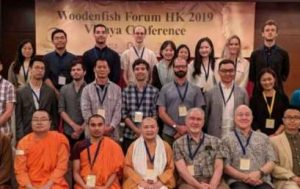
For some months now, the philosopher Amod Lele and I have been discussing the Buddha’s teaching on the lay life. Over the course of our conversation, I have learned from Lele and have worked to hone my own understanding on this aspect of Buddhist ethics.
So far, the discussion has been:
1. Lele on “The Sigālovāda’s vicious mean” (Love of All Wisdom). I’ll abbreviate this as (Vicious).
2. Me on “Sitting with Sigala, a Modern Layperson’s Buddhist Ethics” (BDG), to be abbreviated as (Sitting).
3. Lele on “Reinterpreting the Sigālovāda’s prohibition on theatre” (Love of All Wisdom), abbreviated as (Reinterpreting).
4. Me on “Book Review: Douglass Smith’s A Handbook of Early Buddhist Wisdom” (BDG), abbreviated as (Smith).
5. Lele on “Are we taking up the sutta’s view of household life?” (Love of All Wisdom), abbreviated as (Taking Up).
6. Me on “The Closing of the Monastic-Lay Divide in Modern Buddhism” (BDG), or (Divide). And,
7. Lele on “The goods of lay life” (Love of All Wisdom), or (Goods)
To sum up, in “Vicious,” Lele writes of his worry that the Sigālovāda Sutta strips the household life of a great deal of its value. It does this, in part, by noting the bad consequences of frequenting theatrical shows. Lele suggests that he is sympathetic to the reasoning, but says that if one is to follow it “to its conclusion, it seems to me that one needs to renounce and become a monk.”
It was this line of thought that led me in “Sitting” to conclude that “for Lele, the text is problematic precisely because it does not push the reader to monasticism and a singular focus on ending suffering.” In my interpretation of the sutta, the Buddha’s work is redirecting Sigāla’s energy away from generally fruitless rituals and toward more ethical relationships with those around him.
While Lele seems to be reading the Sigālovāda Sutta in terms of prohibitions and restrictions, I read it in terms of the Buddha’s pragmatic reformulation of common goals of the time. However, Lele corrected me in his next piece, writing that my conclusion about him was incorrect and that he is “against a singular focus on ending suffering” and that he doesn’t “necessarily see monasticism as the ideal human life” (“Reinterpreting”).
Instead, Lele says his concern is that the advice in the Sigālovāda Sutta is just bad. As he looks at my reading of the sutta, he suggests that I am offering a “reinterpretation” as opposed to “what the Sigālovāda actually says” (“Reinterpreting”). I think that here we see our differing approaches to the text. Mine sees context as highly important and is cautious about any prima facie literal interpretation. It also treats the Buddha as a non-systematic thinker who exhibited upāya, or skillful means, in being able to give different individuals teachings that were helpful for their specific needs.
In this way, my reading of the Sigālovāda Sutta is quite traditional, as I have seen no evidence that monastics and laity throughout history have read the sutta in terms of any kind of “prohibition of theater.” However, Lele, reading the text quite literally, suggests that it prohibits theater.
I don’t want to say with certainty that Lele is misreading the sutta. But it appears that way. And if he is misreading it as an overly strict and dour text that sucks the joy out of householder life, it would make sense that he rejects it. But this would take some evidence. And given that theater exists and has existed in relatively conservative Theravāda countries such as Myanmar, Sri Lanka, and Thailand, I see no reason to think that Lele’s interpretation is part of the recent mainstream.
As I noted in my review of Douglass Smith’s A Handbook of Early Buddhist Wisdom (Akalika Press 2021), in many cases we must “have a teacher or the capacity to dig beyond the specific wording of the instructions to perceive the underlying reasoning behind them. Once one understands the reasoning, the difficult work of applying it to one’s own life begins.” (Smith)
Later, Lele agrees that I’ve pushed the point that he is reinterpreting the sutta (“Taking Up”). However, he still suggests that the Sigālovāda Sutta—and other Pāli suttas on lay life—do not offer good ways to think of lay life.
Most recently, Lele has sought to argue that there are goods worthy of human pursuit, irrespective of their connection to the overall Buddhist goal of awakening:
For me there is a deeper question that underlies any answer to the questions in the previous paragraph. That is: are there any goods that it is worthy for human beings to pursue irrespective of their contributions to the alleviation of suffering (and/or the pursuit of truth, correct seeing)? . . . It is pretty clear to me that the Pali suttas, in general, take the answer to that question to be no. And it is that No answer that underlies both the suttas’ advocacy of monasticism as the highest goal, and their viewing of the good household life as the one described in the Sigālovāda: an imperfect approximation of monasticism.
(Love of All Wisdom, “Goods”)
I think this is categorically incorrect. As Bhikkhu Bodhi notes, the Pāli commentaries make clear, based on quotes from the suttas, that the Buddha’s teachings offer three types of benefit: that which is present in this life, that pertaining to the next life, and that related to the ultimate goal. Given this, we can see that the Pāli suttas, when pragmatic, answer “yes.” Only when we are too closely grasping to the third type of benefit here do we either fail to see or devalue the teachings on the first two types of benefits.

As Bodhi says: “While many Western writers on Early Buddhism have focused on this last aspect as almost exclusively representing the Buddha’s original teaching, a balanced presentation should give consideration to all three aspects.” (107) My sense is that Lele, like other Western writers on early Buddhism, is not offering fair balance to texts focusing on non-ultimate goals.
Lele’s tilt is clear when he writes:
Justin says that “the family life has value as part of the path.” I would push on this point: the path to what? And how does family life contribute to it? It seems to me that what Justin is saying here is not the traditional view of the Pali suttas. In the suttas, the magga is a path to the end of suffering, and family life, if anything, interferes with that path.
(Love of All Wisdom, “Goods”)
This seems mistaken as we look at the Buddha’s teachings to householders. The path is one of cultivation of virtues. These virtues can contribute to a good life here and now. They can contribute to future good lives. And they can contribute to ultimate liberation. Family life is seen as a fetter only at the last level.
As we think about the householder’s path, we should understand it as largely focused on benefits in this life, and here the Buddha has much to say. Reading the suttas on lay life as they have been traditionally read, the path can include lay life. It does not interfere with the path, but instead offers fertile ground for developing the virtues of generosity, fortitude, patience, mindfulness, and so on.
Elsewhere in the Buddha’s teachings, we find guidance aimed at the next life. And yet elsewhere, he offers wisdom for those seeking the ultimate goal. By mistakenly comparing the Sigālovāda Sutta to the Buddhist teachings aimed at awakening, Lele makes a category mistake and sees the Buddha’s pragmatic teachings to Sigāla, which seem aimed at moving from ritual and toward more ethical relationships with those around him as, “an imperfect approximation of monasticism” (“Goods”).
My sense is that this is absolutely not what the Buddha meant to teach Sigāla—that his new practices should be compared unfavorably with monasticism. Nor do I think that Theravāda commentators to the present day have read it in this way. Nor should we read it this way. Instead, as Bodhi suggests, the Sigālovāda Sutta should be read in terms of the goods in this life that it helps laypeople secure. Insofar as these represent positive steps in people’s lives, they are and should be taught.
References
Bodhi, Bhikkhu. 2005. In the Buddha’s Words: An Anthology of Discourses from the Pāli Canon. Somerville, MA: Wisdom Publications
See more
Sitting with Sigala, a Modern Layperson’s Buddhist Ethics (BDG)
Reinterpreting the Sigālovāda’s prohibition on theatre (Love of All Wisdom)
Book Review: Douglass Smith’s A Handbook of Early Buddhist Wisdom (BDG)
Are we taking up the sutta’s view of household life? (Love of All Wisdom)
The Closing of the Monastic-Lay Divide in Modern Buddhism (BDG)
The goods of lay life (Love of All Wisdom)
Related features from BDG
The Buddhist Code of Discipline for Householders: An Online Discussion with Buddhist Scholars
Dudjom Lingpa
Book Review: Chenxing Han’s Be the Refuge
How Does the Buddha Relate to Ordinary Beings?
Suffering and Joy on a Buddhist Homestead













For those of us who may or may not have been monastics during part of our lives, but who are in the world at this time, how we are to conduct ourselves in harmony with the Dharma is an ongoing kōan. While we may aspire to a solitary renunciate life, we find ourselves in relationships at all times — with ourselves, others in many contexts, and the planet. Dharma guides us to find the best path within each of those interbeing dynamics. Yes, samsara is vicious. It always has been. But here we are, now, living our lives and responsive to the particularities with which we are faced. That includes a climate crisis of our own making, war, famine, and all the other tragic failures of humanity. Think bodhisattva, not pratyekabuddha.
[…] Sutta, the Pali text so often viewed as a guide to the household life. Justin helpfully begins his latest post with a list of the previous correspondence we have exchanged on the topic so far, so I won’t […]
[…] Sutta, the Pali text so often viewed as a guide to the household life. Justin helpfully begins his latest post with a list of the previous correspondence we have exchanged on the topic so far, so I won’t […]